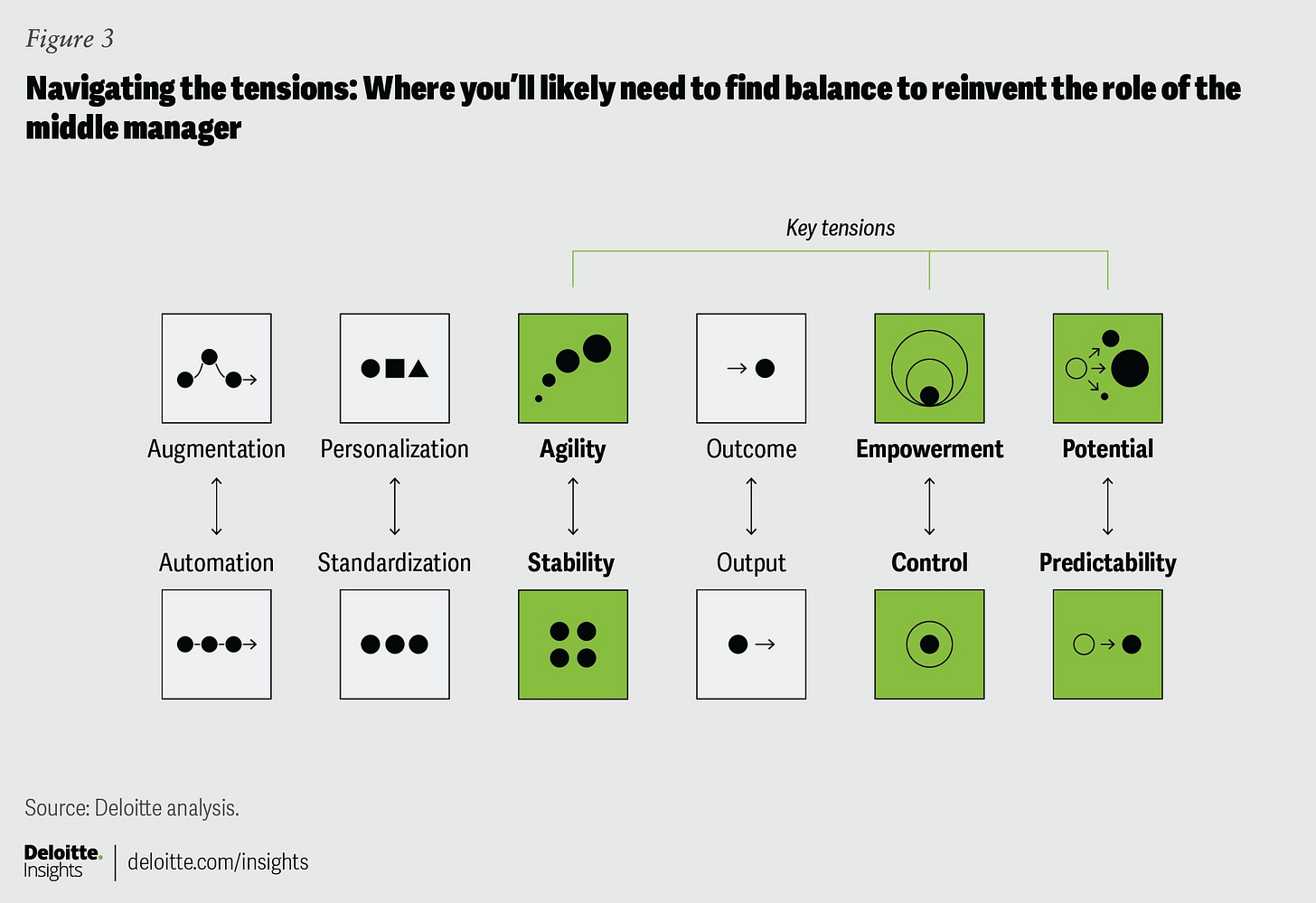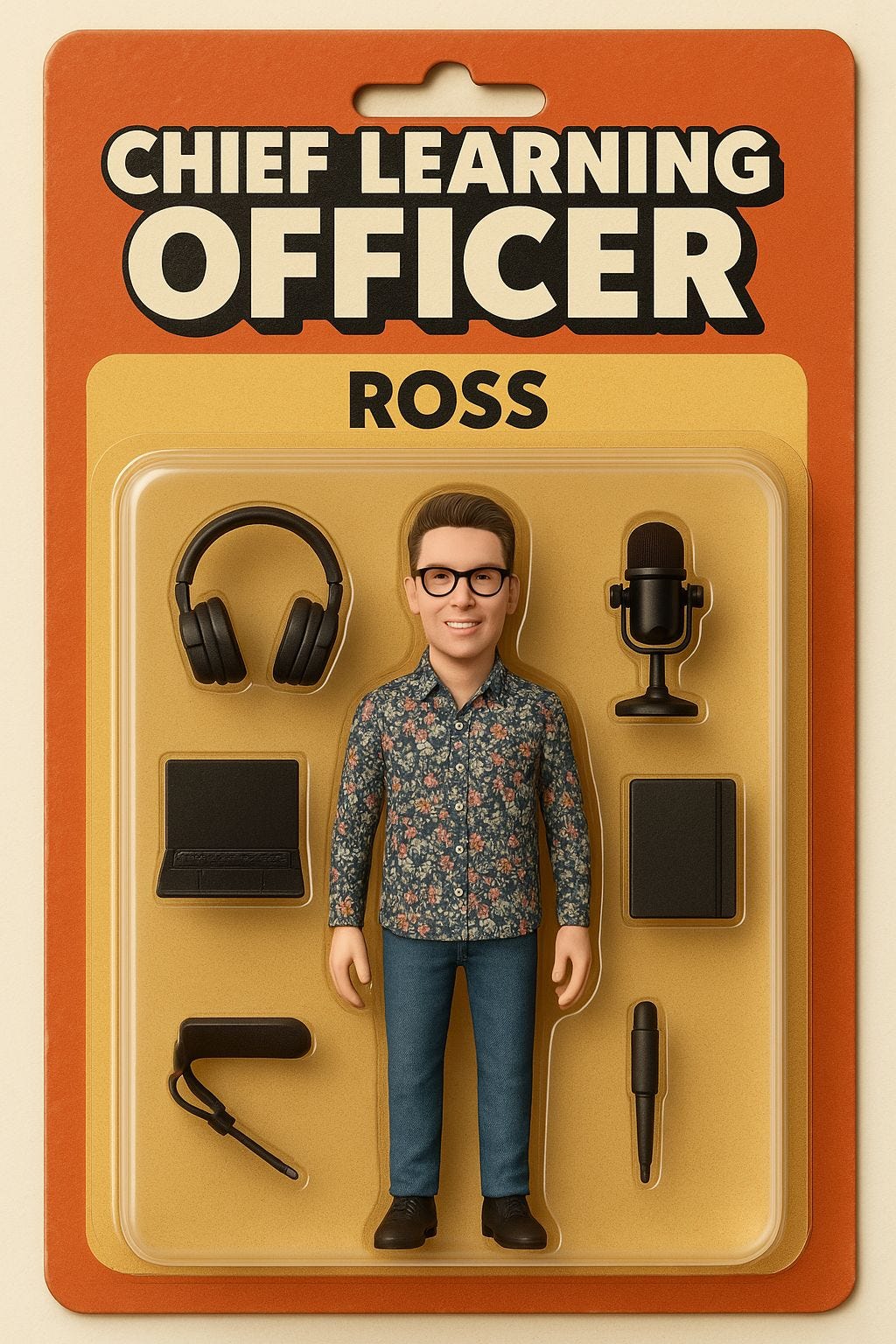AI is gobbling up your managers
But you can help them evolve.
Managers are typically the busiest people you’ll meet.
In our ‘Building Better Managers’ report, my colleague Dr Anna Barnett wrote:
‘Managers have to support decisions they didn’t make, translate organizational goals into actions, identify meaningful opportunities for people to develop, remember to acknowledge successes, regulate their emotions, and resolve team conflicts. They are coaches, learning champions, coordinators, motivators, disseminators, and decision makers.’
They are also, according to a new report from Deloitte, increasingly viewed as unnecessary.
Per Deloitte’s ‘2025 Global Human Capital Trends’ report:
‘US employers were advertising 42% fewer middle management positions at the end of 2024 than they did in the spring of 2022.3 And research by Gartner predicts that through 2026, 20% of organizations will use AI to flatten their organizational structure, eliminating more than half of current middle management positions.4‘ (Emphasis mine)
The theory to cutting out the middle layer of bureaucractic management is most positively described in Gary Hamel and Michele Zanini’s Humanocracy (see our podcast on this):
‘To cure the disabilities that cripple our organizations, we need to be equally radical in reimagining the bureaucratic management model. Building organizations that are endlessly malleable, ridiculously creative, and brimming with passion requires entirely new approaches to mobilizing and coordinating human effort.’
The problem with this is that, in the majority of cases, it doesn’t work.
Per the Deloitte report again:
‘Humans will still lead and be led, even without the formal titles. This can create “shadow leaders” and unclear decision rights that slow the organization rather than create efficiencies… One foundational study revealed that flattened firms with fewer middle managers typically exhibit more control and decision-making at the top—the opposite of what was intended to reduce costs and push decisions downward to improve agility.9‘
While it’s true that AI can gobble up traditional management tasks like administration and resource allocation, this was never the greatest value-add of managers anyway.
Deloitte highlight that the key to great management is the ability to navigate three key tensions:
A manager should ensure organizational agility while providing a sense of stability; empower team members without losing control; and unleash potential without sacrificing some degree of predictability.
Here’s what the report recommends:
⚽ Develop, coach, motivate, and nurture people
The most important thing a manager can do is develop others, boosting performance by as much as 27%. Coaching is key to this, but it’s historically been difficult to make this available to anyone beyond senior leaders. And, if managers haven’t experienced coaching, it’s difficult for them then to use it as a development technique.
One approach to building this capability is Deloitte’s ‘Coaching Skills for Effective Conversations’ programme (developed with Mindtools and shortlisted at the Learning Technologies Awards last year). By using a blend of virtual classrooms, self-paced e-learning and triad practice, Deloitte UK was able to offer a programme to equip everyone at Deloitte with the key coaching skills required to have better professional conversations (whether they’re a manager or not).
Deloitte’s ‘2025 Global Human Capital Trends’ also advocates using AI tools to help managers measure performance and provide meaningful feedback.
🎨 Redesign work, reallocate resources, and optimize human and machine interactions to drive human performance in the age of AI
Managers also occupy a sweet spot in most organizational structures: close enough to the work to understand it, but not so close that they feel wedded to old habits (like, having a human do the job).
As AI agents become essentially a part of the workforce, the modern manager will need to:
‘…oversee AI, in addition to people. In the future, managers may need to manage multiple AI agents working together in an agent ecosystem.’
This is one area of the Deloitte report that I think comes across as utopian. Certainly the manager has a role to play in helping team members transition into new roles: roles where much of the work is completed by an AI.
But navigating the challenges associated with that transition requires empathy, sensitivity and trust. Do your managers have these skills? (Find out!)
🗺️ Enable agility, strategic problem-solving, and innovation
Finally, the manager has a key role in organizational decision-making:
‘Research by INSEAD, for example, found that 80% of transformation programs led by middle managers succeed, compared to only 20% of those led by senior management.29‘
Effective decision-making requires better access to data, collaboration across teams, and insights into what’s working - and what isn’t.
AI tools can help managers here, where organizations invest in them - and where managers are given training on how to work with them.
If you don’t understand what you’re asking, how can you understand the answer?
Final thoughts
The Deloitte report was based on a survey of 10,000 business and HR leaders across sectors and countries and asked respondents how important it was to reinvent the role of the middle manager. 73% recognized the importance.
But only 7% said they were making ‘great progress’.
We know how important managers are to our organizations, but helping them adapt to changing business needs - as fast as is now required - is an almighty challenge.
What’s one capability your managers need most right now – coaching, job design, or AI-powered decision-making?
We’d love to hear your thoughts! Get in touch by emailing custom@mindtools.com or reply to this newsletter from your inbox.
🎧 On the podcast
We might think that what makes our team culture great (or awful) is different from what supports our learning and development, but are they so different?
In this week’s episode of The Mindtools L&D Podcast, Ross D and Gemma are joined by L&D professional turned Culture Manager, Lois Ratcliffe to discuss:
what ‘culture’ is and how it gets measured;
what it takes to have a good feedback culture;
the features of a learning culture.
Check out the episode below. 👇
You can subscribe to the podcast on iTunes, Spotify or the podcast page of our website.
📖 Deep dive — Manager Skills Framework (3 of 12)
For the next instalment in our series of deep dives into the 12 skills that make up our Manager Skills Framework, we’re exploring goal setting.
A 2013 paper from Crossley, Cooper and Wernsing explored the relationship between goal setting and trust within a sales environment, with results nicely summed up by this quote from a study participant:
‘[My district manager] is really a go-getter and inspires others to take initiative and drive sales. The fact that he really walks the talk and works hard for us, rather than expecting us to work hard for his personal gain, makes us want to step up to the challenge and demonstrate our loyalty.’
In essence, when a manager sets challenging targets, team members interpret this on a continuum.
👎 On one end, where trust in the manager is low, team members think the target is out of reach and they’ll be blamed for not hitting it.
👍 At the other, where trust is high, team members think the manager is going to work with them to reach the target and share in the accomplishment - leading to greater motivation.
One of the questions we asked ourselves when we were building our Manager Skills Assessment is, is ‘trust’ really a skill?
Yes, we decided. In so far as managers can learn how to demonstrate behaviors that lead to greater trust within their teams.
Crossley, C. D., Cooper, C. D., & Wernsing, T. S. (2013). Making things happen through challenging goals: Leader proactivity, trust, and business-unit performance. Journal of Applied Psychology, 98(3), 540.
👹 Missing links
🏃🏽♀️ Turning self-directed learning into something “fun”
How often do you see your colleagues demonstrate self-directed learning? Probably, not very much. In this newsletter, our pal Anamaria Dorgo argues that our time in formal education teaches us that learning happens in a straight line. Then, when we enter the real world, we’re suprised that learning is more like parkour: the frankly terrifying sport where practitioners hurl themselves through a concrete jungle. How can we help our colleagues navigate this jungle? For L&D pros, the key is to offer both guidance and room to explore.
⚖️ If your L&D team measures business metrics, you’re in the minority
Despite all the talk of L&D making an impact and demonstrating value, only 21% of L&D teams do so. That’s the case made by my colleague Dr Gent Ahmetaj, writing in Startups Magazine. Measurement is avoided either because of a lack of skill, or because of fear of results. But for businesses to scale, teams need effective learning both at the individual and organizational level: and you can’t tell if your learning is effective if you’re not measuring it.
🤖 New product alert! Mindtools launches M:Coach
We talked recently on our podcast about the variety of discovery mechanisms that help users navigate our Content Hub for managers. Search, a navigation bar and trending topics all point managers to solutions to their in-the-moment problems, but now a new AI layer is offering contextual support and actionable recommendations. In essence, users can now ‘chat with our content’. We’re rolling this out by default to consumer members, and it’s available for enterprise clients too. Get in touch if you’d like to discuss further!
👋 And finally…
Like everyone else, I used the unbelievable image manipulation powers of the latest ChatGPT release to make a dumb action figure of myself.
I’ve seen a few takes on this, that I’d summarize as:
“When I watched Terminator, I didn’t anticipate AI would be such a waste of time.”
“Creating these images is catastrophic for the environment.”
“We should be showing more ambition by applying AI to real-world problems, not faffing around with images.”
While all of these are undoubtedly true, I also think that playing is how we learn how to use new tools and discover their possibilities.
I remember my first coding experience, and the thrill of seeing ‘Hello World’ printed on screen. I also remember creating my first GIF, a dancing image of myself on a web page while ‘Dude Looks Like a Lady’ played in the background.
And let’s not forget that when we created the ability to clone dinosaurs, we used that power to set up a theme park.
All of which is to say, I think it’s OK to go and play for now. The hard work can come after.
👍 Thanks!
Thanks for reading The L&D Dispatch from Mind Tools! If you’d like to speak to us, work with us, or make a suggestion, you can email custom@mindtools.com.
Or just hit reply to this email!
Hey here’s a thing! If you’ve reached all the way to the end of this newsletter, then you must really love it!
Why not share that love by hitting the button below, or just forward it to a friend?





